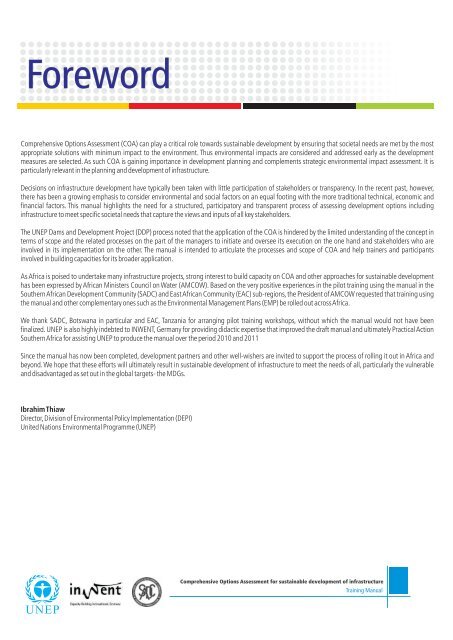Comprehensive Option Assesment - UNEP
Comprehensive Option Assesment - UNEP
Comprehensive Option Assesment - UNEP
Create successful ePaper yourself
Turn your PDF publications into a flip-book with our unique Google optimized e-Paper software.
Foreword<br />
<strong>Comprehensive</strong> <strong>Option</strong>s Assessment (COA) can play a critical role towards sustainable development by ensuring that societal needs are met by the most<br />
appropriate solutions with minimum impact to the environment. Thus environmental impacts are considered and addressed early as the development<br />
measures are selected. As such COA is gaining importance in development planning and complements strategic environmental impact assessment. It is<br />
particularly relevant in the planning and development of infrastructure.<br />
Decisions on infrastructure development have typically been taken with little participation of stakeholders or transparency. In the recent past, however,<br />
there has been a growing emphasis to consider environmental and social factors on an equal footing with the more traditional technical, economic and<br />
financial factors. This manual highlights the need for a structured, participatory and transparent process of assessing development options including<br />
infrastructure to meet specific societal needs that capture the views and inputs of all key stakeholders.<br />
The <strong>UNEP</strong> Dams and Development Project (DDP) process noted that the application of the COA is hindered by the limited understanding of the concept in<br />
terms of scope and the related processes on the part of the managers to initiate and oversee its execution on the one hand and stakeholders who are<br />
involved in its implementation on the other. The manual is intended to articulate the processes and scope of COA and help trainers and participants<br />
involved in building capacities for its broader application.<br />
As Africa is poised to undertake many infrastructure projects, strong interest to build capacity on COA and other approaches for sustainable development<br />
has been expressed by African Ministers Council on Water (AMCOW). Based on the very positive experiences in the pilot training using the manual in the<br />
Southern African Development Community (SADC) and East African Community (EAC) sub-regions, the President of AMCOW requested that training using<br />
the manual and other complementary ones such as the Environmental Management Plans (EMP) be rolled out across Africa.<br />
We thank SADC, Botswana in particular and EAC, Tanzania for arranging pilot training workshops, without which the manual would not have been<br />
finalized. <strong>UNEP</strong> is also highly indebted to INWENT, Germany for providing didactic expertise that improved the draft manual and ultimately Practical Action<br />
Southern Africa for assisting <strong>UNEP</strong> to produce the manual over the period 2010 and 2011<br />
Since the manual has now been completed, development partners and other well-wishers are invited to support the process of rolling it out in Africa and<br />
beyond. We hope that these efforts will ultimately result in sustainable development of infrastructure to meet the needs of all, particularly the vulnerable<br />
and disadvantaged as set out in the global targets- the MDGs.<br />
Ibrahim Thiaw<br />
Director, Division of Environmental Policy Implementation (DEPI)<br />
United Nations Environmental Programme (<strong>UNEP</strong>)<br />
<strong>Comprehensive</strong> <strong>Option</strong>s Assessment for sustainable development of infrastructure<br />
Training Manual
















